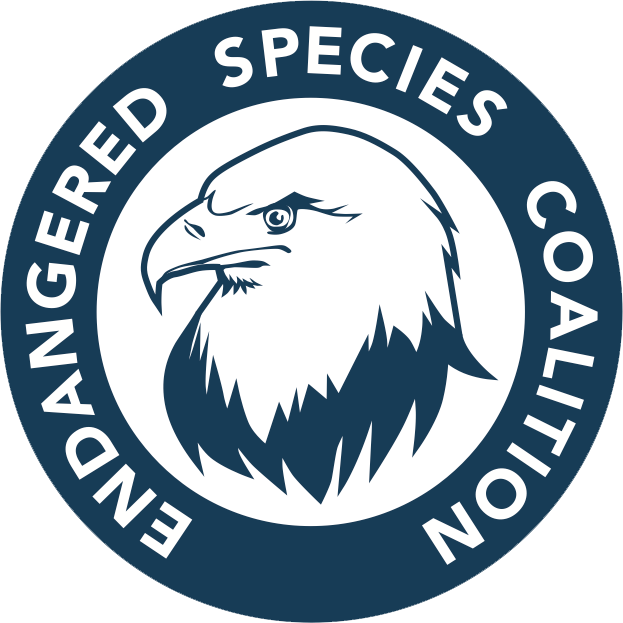The last few weeks have not been easy. I hope everyone is doing well. I have been reaching out to friends and family – and doing a lot of hugging.
And our community is coming together. I was recently so grateful to you all for your tremendous generosity on Giving Tuesday. Thanks to you, we smashed our goal of $10,000, bringing in a total $13,401.
It has also been helpful to reflect on ESC’s history.
The Endangered Species Coalition was born in 1981 — a time of grave danger for wildlife. Concerned about efforts to weaken the Endangered Species Act during its 1982 reauthorization, conservation leaders from the National Audubon Society, Sierra Club, Defenders of Wildlife, Environmental Defense Fund, Earthjustice, and World Wildlife Fund realized that we needed to foster a grassroots force for endangered species. Thus, the ESC was born, and this synergistic movement has grown to over 400 member organizations, 500,000 supporters, and sentinels, defeating every major effort since to undermine the ESA.
We are not afraid of a fight.
And we know one is coming. During the last Trump Administration, we saw new regulations to delist gray wolves across the U.S. and to weaken habitat protections. With a pliant Congress and an even more radical agenda, we know that bedrock laws critical to wildlife are on the chopping block.
But I have hope. Here at ESC our amazing staff is dedicated to one thing, protecting biodiversity. Last week we met for three days to plan our strategy. We have champions in Congress, groups around the country and a powerful community of 500,000 members — we will be mobilizing them all.
This is what gives me hope: our collective love of wildlife, belief in humanity, and commitment to our community. We know that 84% of Americans support a strong Endangered Species Act. We are in this together.
Thank you for your continued support. Together, we are stronger.
Hugs,
Susan

Endangered Species Policy in 2024 and Beyond
By Endangered Species Coalition
 After the consequential United States 2024 elections, one thing remains unchanged – human activities are driving over one million species to extinction. President-elect Trump and the Congressional majority are no friends to wildlife. They will seek to end protections for vulnerable species like wolves, grizzlies, and whales, and roll back the Endangered Species Act itself. Endangered Species Coalition commits to educating, organizing, and mobilizing people who love wildlife so together we can stop their extinction agenda before cherished plant and animal species are lost forever.
After the consequential United States 2024 elections, one thing remains unchanged – human activities are driving over one million species to extinction. President-elect Trump and the Congressional majority are no friends to wildlife. They will seek to end protections for vulnerable species like wolves, grizzlies, and whales, and roll back the Endangered Species Act itself. Endangered Species Coalition commits to educating, organizing, and mobilizing people who love wildlife so together we can stop their extinction agenda before cherished plant and animal species are lost forever.

Organizing for Biodiversity – ESC’s Activist Training Lab and New National Grassroots Organizer
By Dalton George, National Grassroots Organizer

Greetings from the mountains of beautiful Boone, North Carolina. Since our last newsletter, I’ve joined the Endangered Species Coalition team as the new National Grassroots Organizer! I am excited to contribute to the work of the ESC team and coalition.
This Fall, I joined other ESC staff and several member groups in Washington, D.C., for a rally supporting the Tribal Heritage and American Bison, Grizzly Bear, and Wolf Restoration and Coexistence Act. Joining with member groups, I met with North Carolina legislators to discuss critical legislation to protect and improve biodiversity.
I’ve also been hard at work leading the Activist Training Lab. Read more…

The Northern Rockies—Grizzly Bears and a Farewell
By Derek Goldman, Northern Rockies Representative

At the time of this writing, fall is (finally) settling in here in western Montana. Following an extended dry summer, it has begun to snow in the high country. No doubt, grizzly bears are deep in hyperphagia—the annual biological cycle where bears seek to consume as many calories as possible to prepare their bodies for a long winter of hibernation.
The Endangered Species Coalition is also preparing. We anticipate an announcement from the U.S. Fish and Wildlife Service in the next few months that could change the trajectory of grizzly bear recovery in the western U.S., and we are raising the alarm. Read more…

Biodiversity in 30×30 at the America the Beautiful for All Coalition inaugural conference
By Jewel Tomasula, Policy Advisor

With only five years left to achieve the national and global goal to conserve 30% of lands and waters by 2030 (“30×30”), the America the Beautiful for All Coalition held its inaugural conference to discuss top priorities for conservation justice in 2025 and beyond. The Endangered Species Coalition was involved in planning the conference and leading two breakout sessions.
The “Equity-centric Biodiversity Conservation Planning” session highlighted how unjust planning practices have shaped biodiversity loss and discussed how our movement must center the needs of disenfranchised communities in participatory science and biodiversity restoration. Then, the session “More than Acres: Ensuring Effective and Equitable Conservation Beyond 30×30 in Ocean and Coastal Stewardship” called attention to the need for management plans, endangered species and clean water protections, and other tools to ensure that designated protected areas support the biodiversity that communities rely on.
Throughout the conference, people spoke of protecting lands and waters for the wildlife cherished by our communities and sacred to many cultures. We look forward to the new era of bringing the conservation and environmental justice movements together with the America the Beautiful for All Coalition.

Endangered Species Coalition Member Group Highlight
By Tara Thornton, Director of Institutional Engagement

ESC leads the grassroots movement to protect threatened and endangered species and to defend the Endangered Species Act. We believe power is an abundant resource that grows as it is shared.
In each newsletter, we highlight one of our over 400 member organizations and their incredible work to save species and habitats
One of ESC’s newest member groups, Species Unite, is leading the way in lessening animal suffering and promoting coexistence. Read more…

Colorado Border Buffer Zone
By Ryan Sedgeley, Southern Rockies Representative

Wolves don’t understand political boundaries. They need to roam to ensure genetic diversity and to follow prey. Soon, it is likely that Colorado’s state-protected wolves find their way to Wyoming, where they lack any protection. Last year’s horrifying incident in Daniel, Wyoming, where a young female wolf was tortured and killed, illustrates the potential fate for Colorado’s wolves that cross the state border.
That is why the Endangered Species Coalition is calling for the United States Forest Service and the Bureau of Land Management to ban the killing or harassment of gray wolves on their lands. Specifically we want to see these protections in the Medicine Bow National Forest and the land managed in the Rock Springs Field Office.
The agencies have the power to do this, and they should. We hope you will join us in calling for a protective buffer zone for wolves in Wyoming along the northern border of Colorado.

Pollinator Protectors Case Studies
By Jeanne Dodds, Creative Engagement Director

We’re enthusiastic about sharing 2024 Pollinator Protectors campaign success stories with you. What does Pollinator Protectors do, and who benefits from this program? Through Pollinator Protectors, ESC creates native habitat for pollinators and provides outreach and education experiences for communities. Pollinator Protectors allocates small grants for native plant material and related supplies, enabling our partners to create habitat and provide educational events. These projects benefit imperiled native pollinating species, native plants, and communities. Read more… 
Endangered Species Coalition Leads in Keeping Washington Wolves Protected.
By John Rosapepe, Pacific Northwest Representative
A seventeen-month fight to strip Washington State wolves of protection afforded under the state endangered species act was finally defeated by a 5 to 4 vote at the Washington Fish and Wildlife Commission’s July meeting.
Endangered Species Coalition staff and our Washington State volunteers led the grassroots efforts in opposition to the Washington Department of Fish and Wildlife’s proposed downlisting of the wolf’s status from endangered to sensitive.
State protection for wolves is important as wolves are only protected in the western two-thirds of the state under the Endangered Species Act. Read more…

Creative Engagement – Announcing Collaborating for Biodiversity
By Jeanne Dodds, Creative Engagement Director
 It’s never been more important for people and communities to collaborate to ensure that our shared future is biodiverse. That’s why ESC has developed a new creative opportunity for youth grades K-12: Collaborating for Biodiversity. Building on the success of our 2023 Collaborating for Wildlife and Plants call to youth artists in honor of the 50th Anniversary of the Endangered Species Act, we are expanding with a new collaborative call to youth artists during the current academic year.
It’s never been more important for people and communities to collaborate to ensure that our shared future is biodiverse. That’s why ESC has developed a new creative opportunity for youth grades K-12: Collaborating for Biodiversity. Building on the success of our 2023 Collaborating for Wildlife and Plants call to youth artists in honor of the 50th Anniversary of the Endangered Species Act, we are expanding with a new collaborative call to youth artists during the current academic year.
Later this year and in early 2025, we will be sending out updates about how educators and students can join the Collaborating for Biodiversity project, including opportunities for youth artists grades K-12 to collaboratively create works of art in a range of media. The platform for artwork submissions will open in January and close in April 2025. Collaborating for Biodiversity will center species listed, proposed for listing, or recovered from the Endangered Species Act. We will emphasize the creation of artworks increasing awareness of the importance of biodiversity. Read more…



0 comments on “Elections, Activist Training Lab, Grizzlies, Pollinators, 30×30, and more in the Saving Species Newsletter”